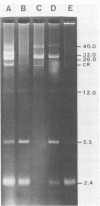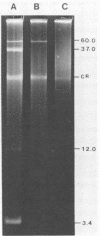Abstract
The antibiotic resistance and virulence profiles of Salmonella spp. isolated from healthy (group 1) and ill (group 2) swine were compared. Parameters studied included colicin and siderophore production; mannose-sensitive hemagglutination of erythrocytes; resistance to the lethal effect of serum complement; resistance to antibiotics; and the transmissibility of these characteristics to recipient organisms. Group 1 (19 isolates) had 14 serotypes, and group 2 (20 isolates) had 2 serotypes. Isolates from group 2 were resistant to more antibiotics and had a greater ability to hemagglutinate erythrocytes and transfer R plasmids to recipient organisms, but a lesser ability to produce siderophore than group 1. All 39 isolates resisted the lethal effects of serum complement. Colicin was produced by 1 of 19 from group 1 and 0 of 20 from group 2. A donor Escherichia coli isolated from a pig with enteritis transferred R plasmids to 62% of group 1 and 0% of group 2 Salmonella spp. when they were used as recipient organisms. A transconjugant from the mating of donor E. coli to a group 1 Salmonella spp. was further able to pass an R plasmid to recipient E. coli and salmonellae. Plasmid isolation from group 1 yielded 1 of 19 strains with a 56-megadalton plasmid, while 20 of 20 strains from group 2 contained three to five plasmids from 2.4 to 60 megadaltons in size.
Full text
PDF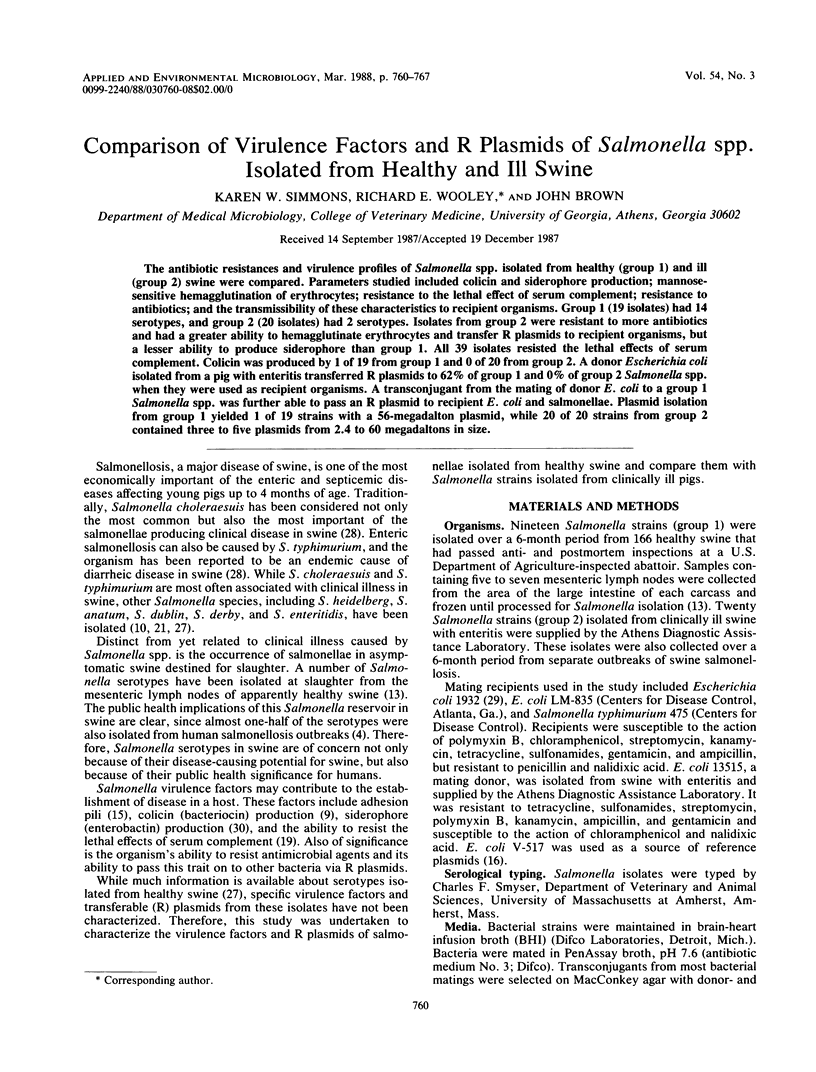
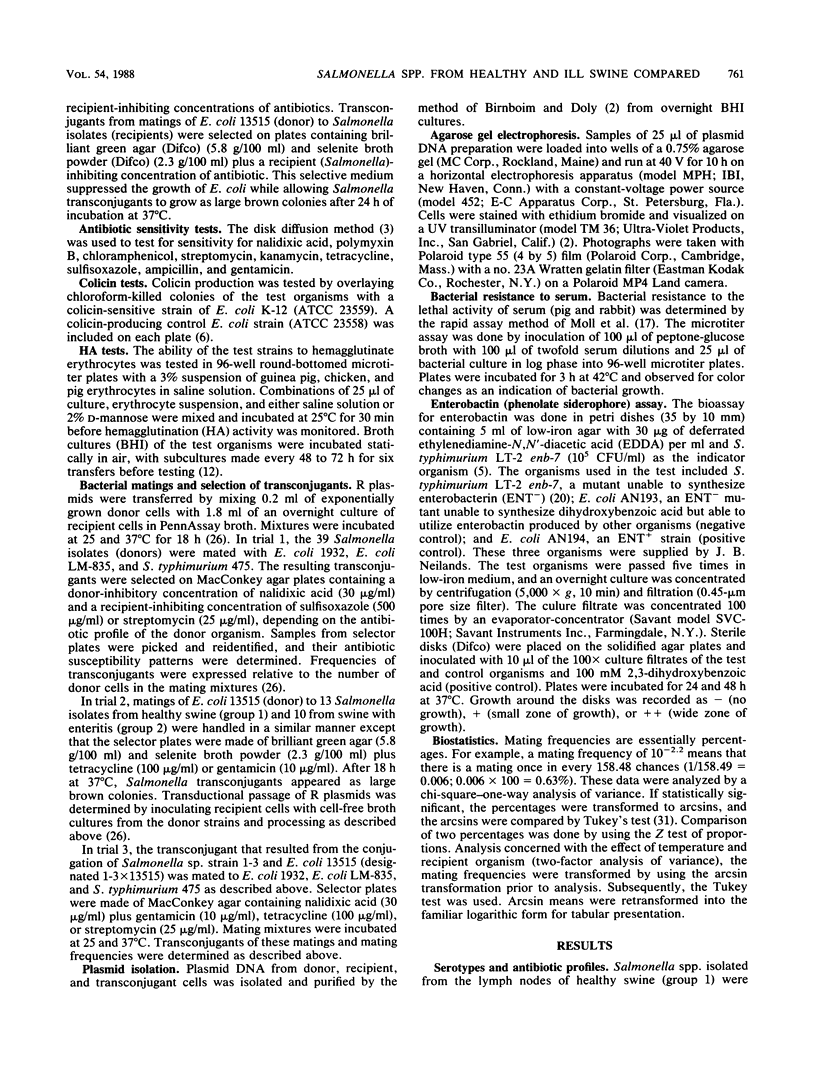
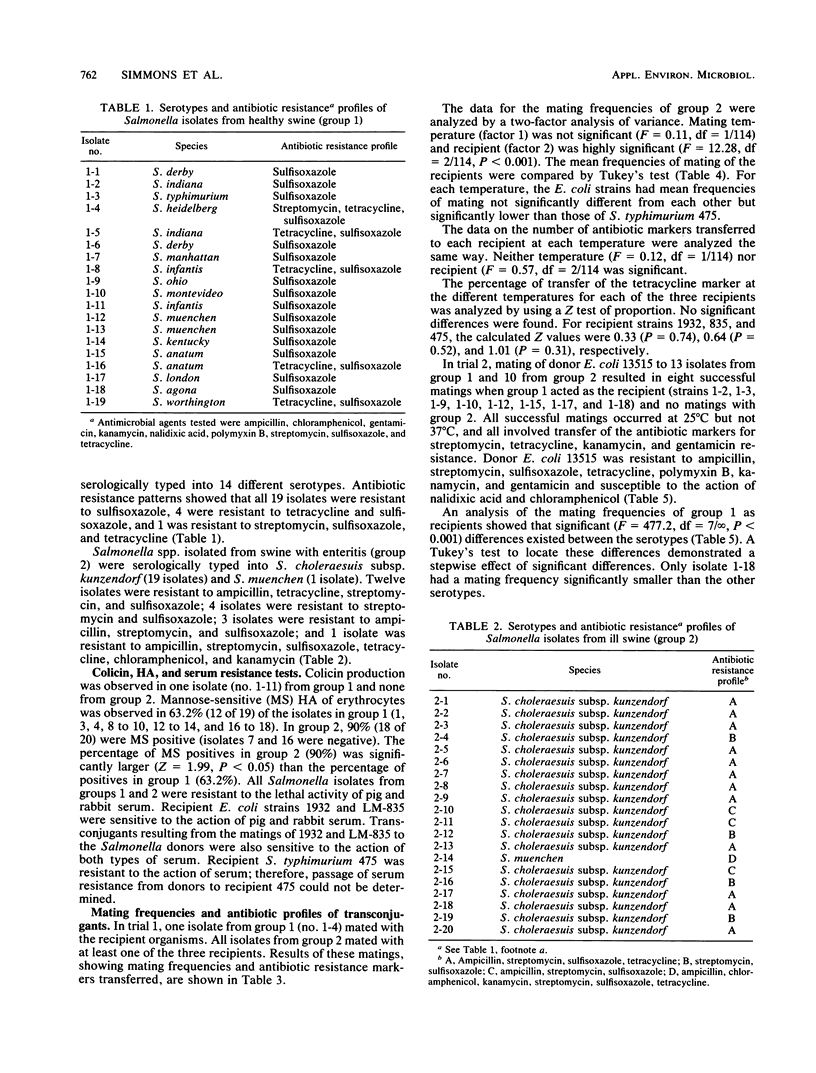
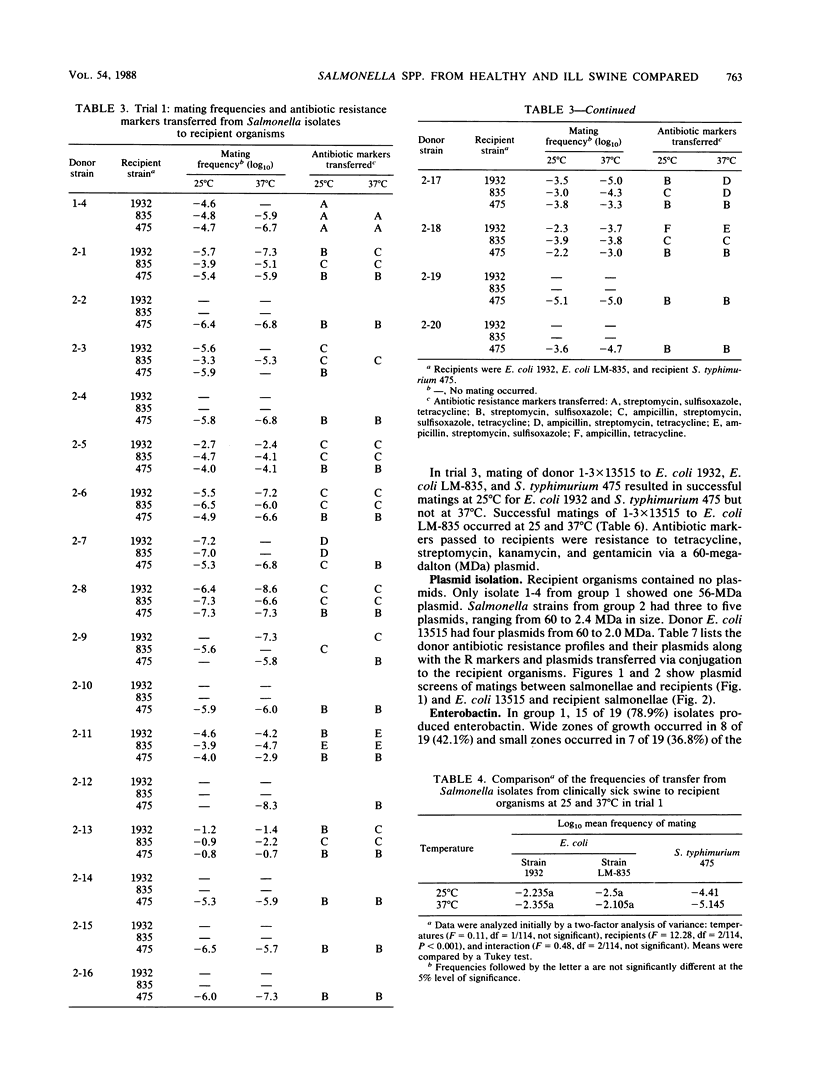
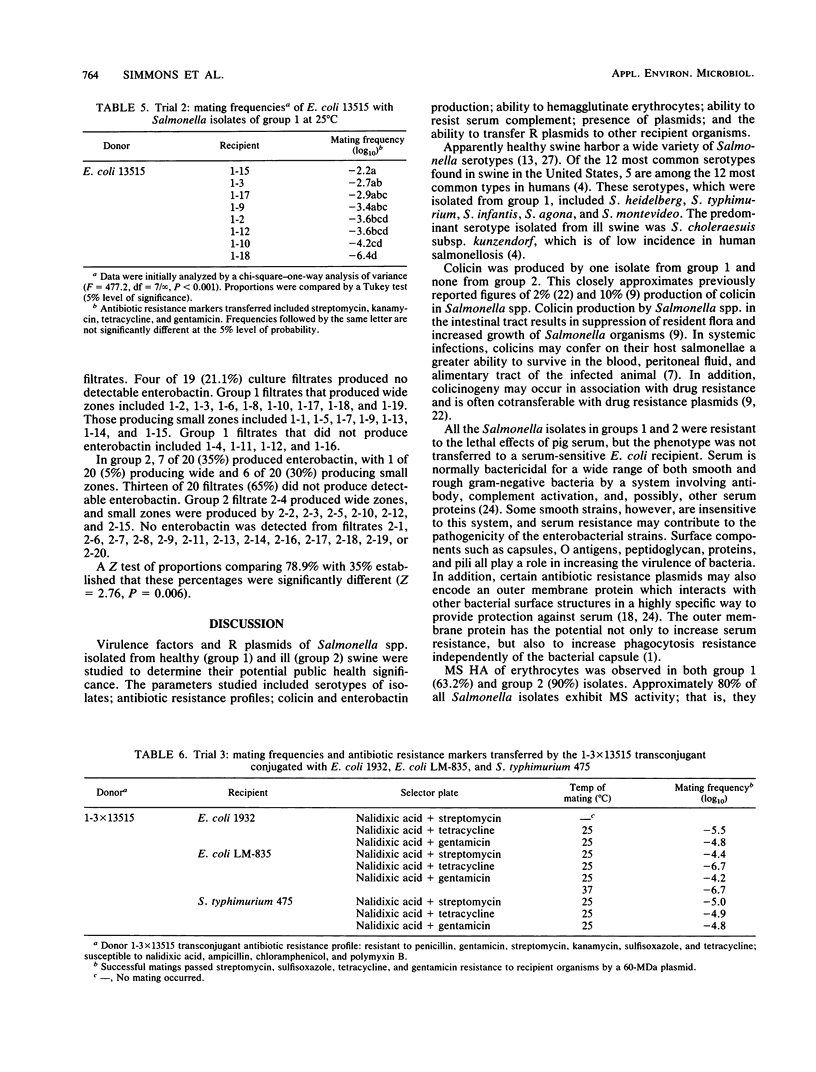
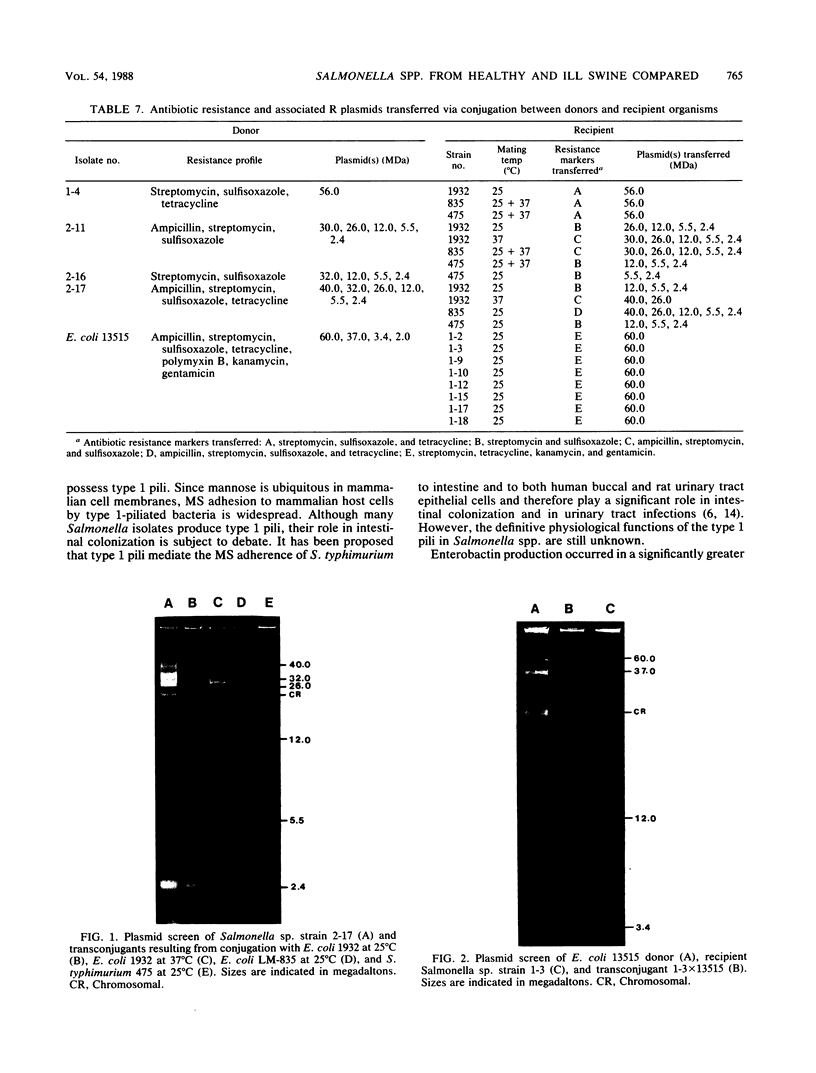
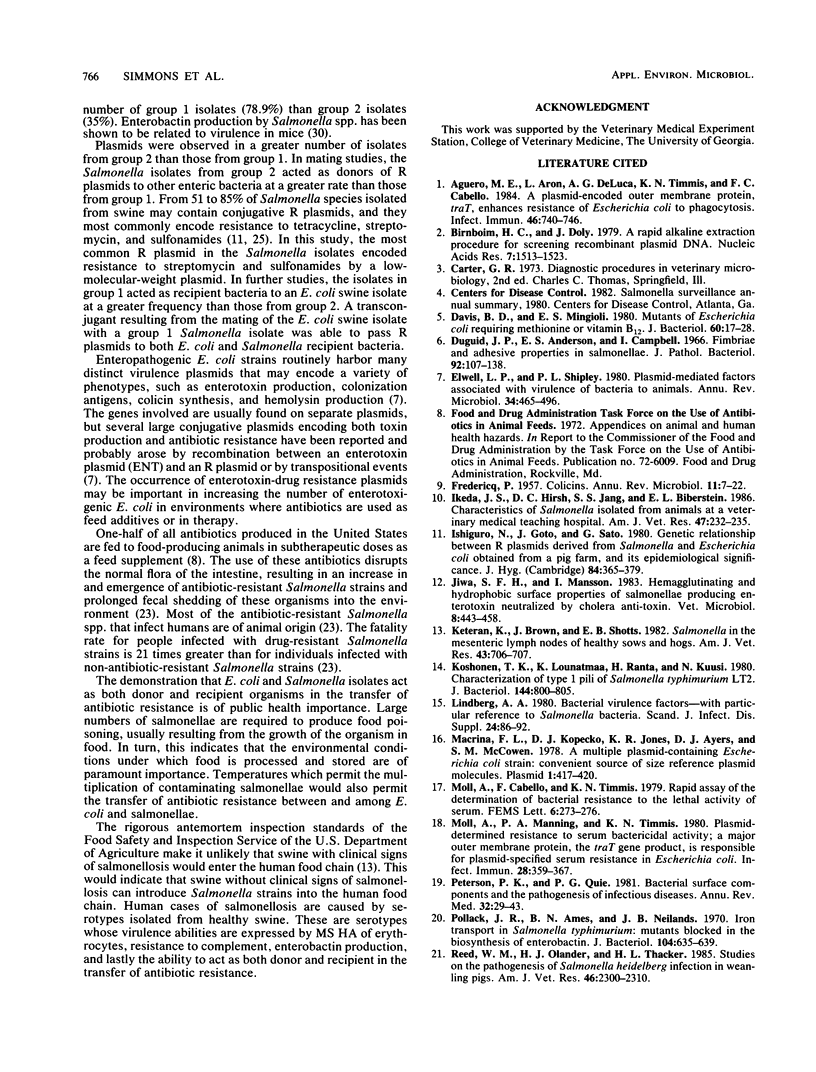
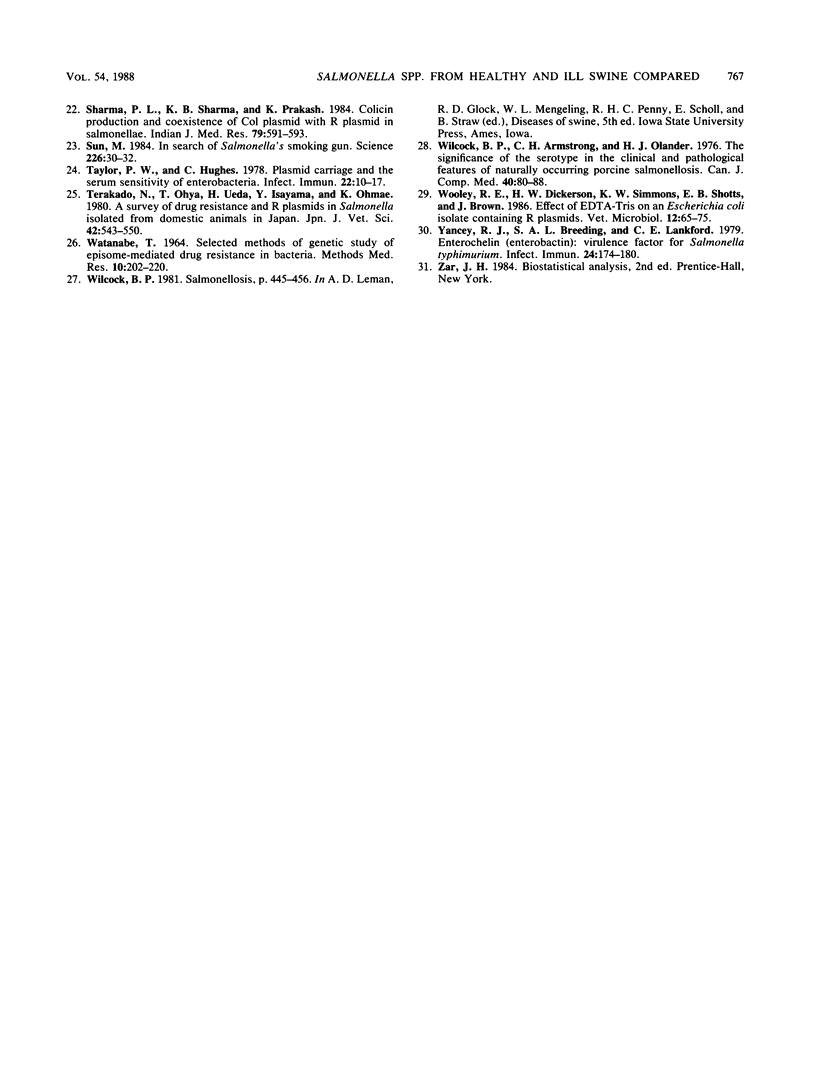
Images in this article
Selected References
These references are in PubMed. This may not be the complete list of references from this article.
- Agüero M. E., Aron L., DeLuca A. G., Timmis K. N., Cabello F. C. A plasmid-encoded outer membrane protein, TraT, enhances resistance of Escherichia coli to phagocytosis. Infect Immun. 1984 Dec;46(3):740–746. doi: 10.1128/iai.46.3.740-746.1984. [DOI] [PMC free article] [PubMed] [Google Scholar]
- Birnboim H. C., Doly J. A rapid alkaline extraction procedure for screening recombinant plasmid DNA. Nucleic Acids Res. 1979 Nov 24;7(6):1513–1523. doi: 10.1093/nar/7.6.1513. [DOI] [PMC free article] [PubMed] [Google Scholar]
- DAVIS B. D., MINGIOLI E. S. Mutants of Escherichia coli requiring methionine or vitamin B12. J Bacteriol. 1950 Jul;60(1):17–28. doi: 10.1128/jb.60.1.17-28.1950. [DOI] [PMC free article] [PubMed] [Google Scholar]
- Duguid J. P., Anderson E. S., Campbell I. Fimbriae and adhesive properties in Salmonellae. J Pathol Bacteriol. 1966 Jul;92(1):107–138. doi: 10.1002/path.1700920113. [DOI] [PubMed] [Google Scholar]
- Elwell L. P., Shipley P. L. Plasmid-mediated factors associated with virulence of bacteria to animals. Annu Rev Microbiol. 1980;34:465–496. doi: 10.1146/annurev.mi.34.100180.002341. [DOI] [PubMed] [Google Scholar]
- FREDERICQ P. Colicins. Annu Rev Microbiol. 1957;11:7–22. doi: 10.1146/annurev.mi.11.100157.000255. [DOI] [PubMed] [Google Scholar]
- Ikeda J. S., Hirsh D. C., Jang S. S., Biberstein E. L. Characteristics of Salmonella isolated from animals at a veterinary medical teaching hospital. Am J Vet Res. 1986 Feb;47(2):232–235. [PubMed] [Google Scholar]
- Ishiguro N., Goto J., Sato G. Genetical relationship between R plasmids derived from Salmonella and Escherichia coli obtained from a pig farm, and its epidemiological significance. J Hyg (Lond) 1980 Jun;84(3):365–379. doi: 10.1017/s0022172400026899. [DOI] [PMC free article] [PubMed] [Google Scholar]
- Jiwa S. F., Månsson I. Hemagglutinating and hydrophobic surface properties of salmonellae producing enterotoxin neutralized by cholera anti-toxin. Vet Microbiol. 1983 Oct;8(5):443–458. doi: 10.1016/0378-1135(83)90039-1. [DOI] [PubMed] [Google Scholar]
- Keteran K., Brown J., Shotts E. B., Jr Salmonella in the mesenteric lymph nodes of healthy sows and hogs. Am J Vet Res. 1982 Apr;43(4):706–707. [PubMed] [Google Scholar]
- Korhonen T. K., Lounatmaa K., Ranta H., Kuusi N. Characterization of type 1 pili of Salmonella typhimurium LT2. J Bacteriol. 1980 Nov;144(2):800–805. doi: 10.1128/jb.144.2.800-805.1980. [DOI] [PMC free article] [PubMed] [Google Scholar]
- Lindberg A. A. Bacterial virulence factors--with particular reference to Salmonella bacteria. Scand J Infect Dis Suppl. 1980;Suppl 24:86–92. [PubMed] [Google Scholar]
- Macrina F. L., Kopecko D. J., Jones K. R., Ayers D. J., McCowen S. M. A multiple plasmid-containing Escherichia coli strain: convenient source of size reference plasmid molecules. Plasmid. 1978 Jun;1(3):417–420. doi: 10.1016/0147-619x(78)90056-2. [DOI] [PubMed] [Google Scholar]
- Moll A., Manning P. A., Timmis K. N. Plasmid-determined resistance to serum bactericidal activity: a major outer membrane protein, the traT gene product, is responsible for plasmid-specified serum resistance in Escherichia coli. Infect Immun. 1980 May;28(2):359–367. doi: 10.1128/iai.28.2.359-367.1980. [DOI] [PMC free article] [PubMed] [Google Scholar]
- Peterson P. K., Quie P. G. Bacterial surface components and the pathogenesis of infectious diseases. Annu Rev Med. 1981;32:29–43. doi: 10.1146/annurev.me.32.020181.000333. [DOI] [PubMed] [Google Scholar]
- Pollack J. R., Ames B. N., Neilands J. B. Iron transport in Salmonella typhimurium: mutants blocked in the biosynthesis of enterobactin. J Bacteriol. 1970 Nov;104(2):635–639. doi: 10.1128/jb.104.2.635-639.1970. [DOI] [PMC free article] [PubMed] [Google Scholar]
- Reed W. M., Olander H. J., Thacker H. L. Studies on the pathogenesis of Salmonella heidelberg infection in weanling pigs. Am J Vet Res. 1985 Nov;46(11):2300–2310. [PubMed] [Google Scholar]
- Sharma P. L., Sharma K. B., Prakash K. Colicin production & coexistence of Col+ plasmid with R-plasmid in Salmonellae. Indian J Med Res. 1984 May;79:591–593. [PubMed] [Google Scholar]
- Sun M. In search of Salmonella's smoking gun. Science. 1984 Oct 5;226(4670):30–32. doi: 10.1126/science.6566452. [DOI] [PubMed] [Google Scholar]
- Taylor P. W., Hughes C. Plasmid carriage and the serum sensitivity of enterobacteria. Infect Immun. 1978 Oct;22(1):10–17. doi: 10.1128/iai.22.1.10-17.1978. [DOI] [PMC free article] [PubMed] [Google Scholar]
- Terakado N., Ohya T., Ueda H., Isayama Y., Ohmae K. A survey on drug resistance and R plasmids in Salmonella isolated from domestic animals in Japan. Nihon Juigaku Zasshi. 1980 Oct;42(5):543–550. doi: 10.1292/jvms1939.42.543. [DOI] [PubMed] [Google Scholar]
- WATANABE T. SELECTED METHODS OF GENETIC STUDY OF EPISOME-MEDIATED DRUG RESISTANCE IN BACTERIA. Methods Med Res. 1964;10:202–220. [PubMed] [Google Scholar]
- Wilcock B. P., Armstrong C. H., Olander H. J. The significance of the serotype in the clinical and pathological features of naturally occurring porcine salmonellosis. Can J Comp Med. 1976 Jan;40(1):80–88. [PMC free article] [PubMed] [Google Scholar]
- Wooley R. E., Dickerson H. W., Simmons K. W., Shotts E. B., Jr, Brown J. Effect of EDTA-tris on an Escherichia coli isolate containing R plasmids. Vet Microbiol. 1986 Jun;12(1):65–75. doi: 10.1016/0378-1135(86)90042-8. [DOI] [PubMed] [Google Scholar]
- Yancey R. J., Breeding S. A., Lankford C. E. Enterochelin (enterobactin): virulence factor for Salmonella typhimurium. Infect Immun. 1979 Apr;24(1):174–180. doi: 10.1128/iai.24.1.174-180.1979. [DOI] [PMC free article] [PubMed] [Google Scholar]



